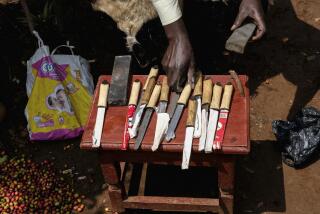In parts of Africa, people with albinism are hunted for their body parts. The latest victim: a 9-year-old boy

Superstitions hold that the body parts can bring riches, success, power or sexual conquest. (June 15, 2017) (Sign up for our free video newsletter here http://bit.ly/2n6VKPR)
Reporting from JOHANNESBURG, South Africa — On a Thursday night in early March, a Malawian man named Gilbert Daire was woken by the sound of people trying to drill through his wall. He was convinced that hunters had come to kill him for his body parts.
When his wife screamed, neighbors came to help and fended off the attackers. But Daire no longer feels safe in the streets or at home. He worries that the hunters will return.
Daire has albinism, a condition that makes him a valuable commodity in parts of eastern and southern Africa. Like elephants and rhino, they are hunted and killed for their body parts, which can fetch thousands of dollars and are often trafficked across borders.
Slayings of people with albinism are common in Tanzania, Malawi and Mozambique, where body parts are used in witchcraft rituals because of superstitions that they can bring riches, success, power or sexual conquest. Children are especially vulnerable.
At least 20 Malawians with albinism have been killed for their body parts since November 2014, according to Amnesty International. But the number could be higher, with many other people with albinism having disappeared. In Tanzania, at least 75 have been killed since 2000.
The danger has become so significant that the United Nations refugee organization has recently begun relocating families of people with albinism in Malawi to Canada and other countries.
The recessive genetic condition, which limits the body’s production of melanin and results in lack of pigmentation in skin, hair and eyes — often leading to skin cancer or eye damage — affects as many as 1 in every 1,400 people in Africa.
Because people with the condition there are so visible in their communities, they are often forced to hide in their houses to avoid attack, abduction and slaughter. But even there they are not safe.
The attacks are often brazen: Homes are invaded or people are seized in broad daylight. Toddlers and children are snatched from impoverished single mothers or while walking to school. Family members such as uncles, fathers or boyfriends are often implicated.
Their mutilated bodies are often found later without hands, feet, breasts, genitals, skin, eyes or hair — depending on the spells to be cast.
The latest apparent victim was a 9-year-old Malawian boy named Mayeso Isaac, who was traveling to visit relatives late last month when he was attacked and abducted by a gang of 10 men. He has not been seen since and it is feared he was killed for his body parts. It was part of a familiar pattern.
Other recent young victims in Malawi: 2-year-old Whitney Chilumpha, whose teeth and clothes were found dumped in a neighboring village; 9-year-old Harry Mokoshini, whose head was recovered by police; and teenager David Fletcher, whose body was found without hands or feet.
Edna Cedric lost one son to body part hunters. When they later returned for his twin brother, she was ready and managed to fight them off.
Deprose Muchena, a spokesman for Amnesty International, said deep-seated cultural traditions persist, including a belief in mythical powers of people with albinism and a conviction that their body parts could change lives, bringing fabulous wealth, power or good fortune. Some believe that albinos are not human, that their only value is monetary and that they have gold in their bones.
“It’s a readiness to believe in mythical expectations about how you create wealth,” Muchena said. “These are false, deep-seated beliefs that need to be eliminated in society. These beliefs feed on ignorance from the lack of education that afflicts a number of people in Malawi, particularly in rural areas.”
Many people with albinism in Malawi live in remote, impoverished communities where education levels are low, superstitions are common, unemployment is high, and information about albinism is not available. Women who give birth to children with albinism are sometimes shunned.
Killings of people with albinism also occur in South Africa, although these are less common. In February, a 67-year-old traditional healer there was convicted of murdering a 20-year-old woman with albinism and sentenced to life in prison.
The healer, Bhekukufa Gumede, and four young accomplices removed the genitals, limbs and skin of the victim, Thandazile Mpunzi, and tossed her body into a shallow grave. Two of the accomplices told the court that Gumede convinced them that they would get rich if they ingested traditional medicine with the body parts.
The victim’s boyfriend, who helped lure her to her death, was sentenced to 18 years while three others were given 20-year terms.
Muchena said poor policing and an inept criminal justice system in Malawi contributed to the attacks on people with albinism there, with nobody convicted in any of the 20 known slayings there in the last three years.
Even suspects found with bones or other body parts were released because of errors by prosecutors or acquitted by poorly trained magistrates.
Muchena said a government task force to tackle the problem had also failed to deliver.
After a series of attacks this year, Malawian police chief Lextern Kachama told local media that the president had ordered police to protect schools from the hunters and called on communities to do more.
“People in the communities play very crucial roles in the protection of people with albinism because they stay with them all the time,” he said.
To read the article in Spanish, click here
Twitter: @RobynDixon_LAT
ALSO
He lost a leg to a shark. Now he’s trying to save the species
The day road rage led to a treason charge in Zambia, as democracy falters in Africa
One of South Africa’s top tourist destinations is almost out of water
More to Read
Sign up for Essential California
The most important California stories and recommendations in your inbox every morning.
You may occasionally receive promotional content from the Los Angeles Times.










